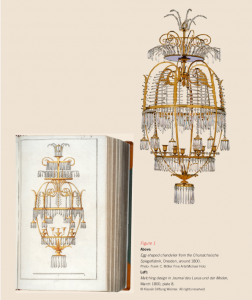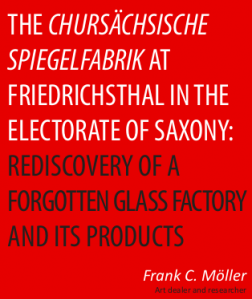

This article aims to rescue from oblivion one of the most important German glass factories of the eighteenth and early nineteenth centuries: the Chursächsische Spiegelfabrik, or Mirror Factory of the Electorate of Saxony, founded by the Elector at Friedrichsthal, north of Dresden, in 1709. Using new research results, it traces the history of the factory and analyses the factors that led to its heyday from 1787, when, as well as mirrors, it started producing plain and coloured glass objects for the table and interior decoration, such as fruit bowls, candelabra, jugs, and so on, as well as lamps and chandeliers. Its international success culminated with the introduction of semi-opaque white bone glass in 1794, until production ceased in 1815.
Please click on the link to open the PDF and read the full essay: moller_essay_pm_v02
The Essay is also to be found on the website of the además de, the Applied Arts Museum in Madrid, Spain and is published here with their kind permission:
http://www.ademasderevista.com/index.php/ADD/issue/view/14
Bitte klicken Sie auf den Link, um die PDF-Datei zu öffnen und den vollständigen Aufsatz zu lesen (Englisch)
Der Aufsatz ist auch auf der Website des Museums für Angewandte Kunst in Madrid, Spanien, zu finden und wird hier mit deren freundlicher Genehmigung veröffentlicht: http://www.ademasderevista.com/index.php/ADD/issue/view/14
Dieser Artikel will eine der bedeutendsten deutschen Glasfabriken des 18. und frühen 19. Jahrhunderts dem Vergessen entreißen: die Kurfürstlich-sächsische Spiegelfabrik, 1709 vom Kurfürsten in Friedrichsthal nördlich von Dresden gegründet. Auf der Grundlage neuer Forschungsergebnisse zeichnet sie die Geschichte der Fabrik nach und analysiert die Faktoren, die zu ihrer Blütezeit ab 1787 führten, als sie neben Spiegeln auch Gegenstände aus einfachem und farbigem Glas für den Tisch und die Inneneinrichtung wie Obstschalen, Kandelaber, Krüge usw. sowie Lampen und Leuchter produzierte. Der internationale Erfolg gipfelte in der Einführung von halbopakem weißem Knochenglas im Jahr 1794, bis die Produktion 1815 eingestellt wurde.
No Comments, Comment or Ping
Reply to “The Chursächsische Spiegelfabrik at Friedrichsthal in the Electorate of Saxony: Rediscovery of a Forgotten Glass Factory and its Products from Frank C. Möller, Art dealer and researcher”